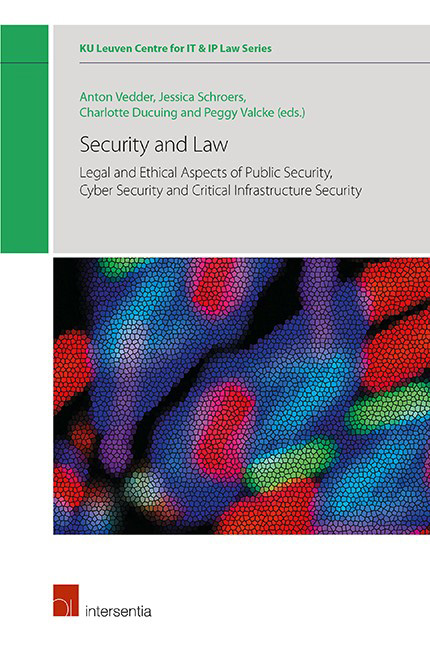 Security and Law
Security and Law Book contents
- Frontmatter
- Contents
- List of Contributors
- Chapter 1 Introduction: Security and Law in a Digitizing World
- Chapter 2 Safety, Security and Ethics
- Chapter 3 National and Public Security within and beyond the Police Directive
- Chapter 4 Criminal Profiling and Non-Discrimination: On Firm Grounds for the Digital Era?
- Chapter 5 Operationalization of Information Security through Compliance with Directive 2016/680 in Law Enforcement Technology and Practice
- Chapter 6 Protecting Human Rights through a Global Encryption Provision
- Chapter 7 Identity Management and Security
- Chapter 8 Towards an Obligation to Secure Connected and Automated Vehicles “by Design”?
- Chapter 9 The Cybersecurity Requirements for Operators of Essential Services under the NIS Directive – An Analysis of Potential Liability Issues from an EU, German and UK Perspective
- Chapter 10 The ‘by Design’ Turn in EU Cybersecurity Law: Emergence, Challenges and Ways Forward
- Chapter 11 Promoting Coherence in the EU Cybersecurity Strategy
- Chapter 12 Challenges of the Cyber Sanctions Regime under the Common Foreign and Security Policy (CFSP)
- Chapter 13 International (Cyber)security of the Global Aviation Critical Infrastructure as a Community Interest
- Cumulative Bibliography
- Miscellaneous Endmatter
Chapter 1 - Introduction: Security and Law in a Digitizing World
Published online by Cambridge University Press: 23 January 2020
- Frontmatter
- Contents
- List of Contributors
- Chapter 1 Introduction: Security and Law in a Digitizing World
- Chapter 2 Safety, Security and Ethics
- Chapter 3 National and Public Security within and beyond the Police Directive
- Chapter 4 Criminal Profiling and Non-Discrimination: On Firm Grounds for the Digital Era?
- Chapter 5 Operationalization of Information Security through Compliance with Directive 2016/680 in Law Enforcement Technology and Practice
- Chapter 6 Protecting Human Rights through a Global Encryption Provision
- Chapter 7 Identity Management and Security
- Chapter 8 Towards an Obligation to Secure Connected and Automated Vehicles “by Design”?
- Chapter 9 The Cybersecurity Requirements for Operators of Essential Services under the NIS Directive – An Analysis of Potential Liability Issues from an EU, German and UK Perspective
- Chapter 10 The ‘by Design’ Turn in EU Cybersecurity Law: Emergence, Challenges and Ways Forward
- Chapter 11 Promoting Coherence in the EU Cybersecurity Strategy
- Chapter 12 Challenges of the Cyber Sanctions Regime under the Common Foreign and Security Policy (CFSP)
- Chapter 13 International (Cyber)security of the Global Aviation Critical Infrastructure as a Community Interest
- Cumulative Bibliography
- Miscellaneous Endmatter
Summary
Few people would doubt the importance of security of a state, society, its organizations and institutions, and individuals as an unconditional basis for personal and societal flourishing. Equally few people would deny being concerned by the oft en-occurring conflicts between security and other values and fundamental freedoms and rights, such as individual autonomy or privacy to name but a few. While the search for a balance between these public values is far from new, ICT and data-driven technologies have undoubtedly given it a new impulse. These technologies have a complicated and multifarious relationship with security.
Based on their knowledge discovery capacity – e.g. in the form of big data analysis – they are powerful tools in the hands of public authorities in charge of public and national security. In other words, they can have an instrumental function to security. Protection of citizens and individuals from abuses committed by public authorities having a monopoly of legitimate violence is far from new and has been a major task of the law, especially at national and EU levels. By significantly reinforcing the security public authorities, these new technologies may affect the balance of power to the detriment of citizens in many ways. There is a need for reconsidering the balance between the pursuit of public and national security, on the one hand, and the legitimate interests and fundamental rights of citizens, on the other.
Moreover, these new technologies have pervaded our daily environment to the point that they have become critical to the functioning of the economy and of society at large. Against this background, they themselves are increasingly perceived as requiring security, for example when they lie at the core of essential societal services such as healthcare, energy, education or mobility. Safeguarding the security of ICT and data-driven technologies is, however, a challenging endeavour. Amongst others, one has to deal with their inherent connectedness, which makes them liable to the ‘least secured link of the chain’ risk. The anonymity and global scale of the internet multiplies their risk exposure. Furthermore, while security is pursued to the benefit of all, who is or should be made responsible for achieving it remains a highly debated question.
- Type
- Chapter
- Information
- Security and LawLegal and Ethical Aspects of Public Security, Cyber Security and Critical Infrastructure Security, pp. 1 - 10Publisher: IntersentiaPrint publication year: 2019
